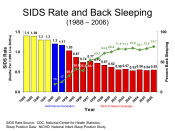Smoking and sudden infant death syndrome (SIDS)
Introduction
Sudden Infant Death Syndrome (SIDS), has experienced a marked decrease in prevalence over the past ten years. However continues to be responsible for more infant deaths beyond the neonatal period than any other cause of death during infancy in the United States (Arias et al. 2002). The most recent data estimates 0.56 SIDS deaths per 1000 live births in 2001, which is significantly down from 1.2 deaths per 1000 live births in 1992 (Mathews et al., 2003). Although the cause of SIDS remains unknown, it is defined as "the sudden death of an infant under 1 year of age which remains unexplained after a thorough case investigation, including performance of a complete autopsy, examination of the death scene, and review of the infant's clinical history" (Willinger et al., 1991). The American Academy of Pediatrics (AAP), in an updated policy statement published in November 2005, states that the consistently identified risk factors across studies are: prone sleep position, sleeping on a soft surface, maternal smoking during pregnancy, overheating, late or no prenatal care, young maternal age, preterm birth and/or low birth weight, and male gender.
They also note that consistently higher rates are found in African American and American Indian / Alaska Native children at two to three times the national average.
The decline SIDS cases have been attributed to the wide-spread campaigns promoting supine positioning for infant sleep (AAP, 2005). As that intervention is now well established, there is a need to explore other major contributing factors so that further progress can be made in the prevention of SIDS. The second most significant risk is infant exposure to tobacco smoke, both in utero and postnatally. There has been much research establishing the link between maternal tobacco smoking during pregnancy and SIDS...


